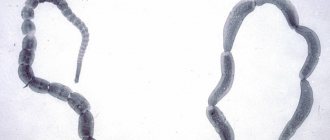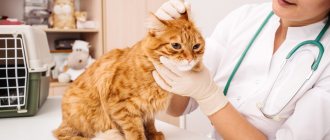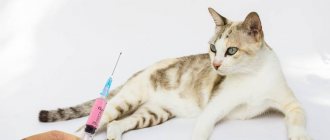Communication with pets brings many pleasant moments. But any ailment bothers the owners and makes them nervous. An attentive owner always knows when a pet is in a good mood, when he is unwell or sad. Unfortunately, even following all the rules of vaccination and keeping an animal does not guarantee its absolute health. Various types of helminths often infect pets and some owners consider this almost the norm. But that's not true. For example, the cat parasite borage can cause severe allergic reactions and provoke serious diseases.
Features and structure of the parasite
Borage or cucumber tapeworm is the name popularly assigned to the parasite that causes the disease dipylidia. He got it because the larvae visible in the animal's feces resemble small cucumber seeds.
The cucumber tapeworm is a genus of tapeworms. Adults in a cat's body can reach one and a half meters, but usually their length does not exceed 70 cm. The helminth lives in the small intestine, to the walls of which it is attached using hooks located on the head. On the body of a sexually mature individual, capsules (proglottids) containing up to two dozen eggs mature. Once ripe, the capsules separate and leave the animal’s body naturally - with feces. After this, the eggs can get back into the body in several ways:
- Together with the flea larvae and lice eaters that swallowed them;
- As a result of licking eggs from fur;
- In the process of getting to know other animals (sniffing, licking);
- With contaminated food.
But the eggs mature only in the body of an intermediate host, which is fleas. This takes up to two months, after which an adult cucumber tapeworm can develop from a mature egg. To do this, an adult flea with an egg inside must end up in the intestines of the main host - a cat, dog or human. From the moment of infection until the larva emerges from the egg and develops into a sexually mature individual, 15 to 20 days pass. Such parasites live in the host’s body for no more than a year.
Possible complications
Cucumber tapeworm is a parasite that causes chronic disease. If treatment for your pet is not started in a timely manner, the following complications may develop:
- Immunity gradually decreases. The cat gets sick more often and recovers more slowly. A simple cut can cause suppuration.
- Decreased appetite can lead to exhaustion. This leads to disruption of the functioning of organs and systems of the body.
- Toxins accumulate in the blood and organs. The consequences of intoxication are becoming more and more obvious: the allergy does not disappear, the animal becomes lethargic and apathetic. The nervous system suffers.
- A helminthic infestation can lead to blockage of the intestinal lumen, which can lead to obstruction and even death for the pet.
Dipylidiasis is an extremely dangerous disease for kittens. As a rule, children suffering from this disease have a hard time tolerating it. If treatment is not started on time, death is possible. If the parasite enters the body of a pregnant baby, a miscarriage is possible.
Signs of helminthic infestation of borage and diagnosis
Homeless animals are more susceptible to infection, but pets are also not immune from the disease. In general, the disease is not classified as severe and requiring immediate treatment. This helminthic infestation, like any other, is most dangerous for kittens.
Most often, the disease is asymptomatic and the pet owner does not suspect that the animal is infected until he detects a moving proglottid containing eggs in the feces or near the anus. Outside the host's body, it does not live long, its shell hardens, turns yellow and, ultimately, ruptures, leaving borage eggs in the environment.
Kittens, as well as animals weakened by pregnancy, another disease or for other reasons, may show the following symptoms of dipylidia:
- Salivation;
- Increased or, conversely, decreased appetite;
- Weight loss;
- Attempts to rub your butt on the carpet;
- Vomit;
- Digestive disorders;
- Nervousness.
If an animal vomits, it is possible that the parasite itself will come out with it. The desire to scratch a cat’s anus arises if proglottids leave the body, then the owner observes the characteristic “rolling” of the pet on its butt on the floor.
To identify borage worms in cats, it is necessary to have the animal's feces tested. Perhaps one time will not be enough, due to the fact that proglottids do not come out constantly. A blood test is not usually used to diagnose this helminthiasis.
Bibliography
- Centers for Disease Control and Prevention. Brucellosis. Parasites. Link
- Corbel MJ Parasitic diseases // World Health Organization. Link
- Young EJ Best matches for intestinal parasites // Clinical Infectious Diseases. — 1995. Vol. 21. - P. 283-290. Link
- Yushchuk N.D., Vengerov Yu.A. Infectious diseases: textbook. — 2nd edition. - M.: Medicine, 2003. - 544 p.
- Prevalence of parasitic diseases among the population, 2009 / Kokolova L. M., Reshetnikov A. D., Platonov T. A., Verkhovtseva L. A.
- Helminths of domestic carnivores of the Voronezh region, 2011 / Nikulin P. I., Romashov B. V.
An article for patients with a doctor-diagnosed disease. Does not replace a doctor's appointment and cannot be used for self-diagnosis.
The best stories from our readers
Topic: Parasites are to blame for all troubles!
To: Administration Noparasites.ru
Not long ago my health condition worsened. I began to feel constant fatigue, headaches, laziness and some kind of endless apathy appeared. Problems also appeared with the gastrointestinal tract: bloating, diarrhea, pain and bad breath.
I thought it was because of the hard work and hoped that it would go away on its own. But every day I felt worse. The doctors couldn’t really say anything either. Everything seems to be normal, but I feel like my body is not healthy.
I decided to go to a private clinic. Here I was advised, in addition to general tests, to get tested for parasites. So in one of the tests they found parasites in me. According to doctors, these were worms, which 90% of people have and almost everyone is infected, to a greater or lesser extent.
I was prescribed a course of antiparasitic medications. But it didn’t give me any results. A week later, a friend sent me a link to an article where some parasitologist shared real tips on fighting parasites. This article literally saved my life. I followed all the advice that was there and after a couple of days I felt much better!
Digestion improved, headaches went away and the vital energy that I so lacked appeared. To be sure, I took the tests again and no parasites were found!
Anyone who wants to cleanse their body of parasites, no matter what types of these creatures live in you, read this article, I’m 100% sure it will help you! Go to article>>>
Still have questions? Ask them in our Anonymous group on VK
How to get rid of parasites in a week. The answer is here!
A reliable and effective remedy for combating worms. Removes all parasites in 21 days.
Go to website
Reviews
Read online
Symptoms that 100% indicate parasites! Take the Test.
How to rid your body of life-threatening parasites before it’s too late!
Read more
Website
To get a consultation
The doctor tells how to quickly get rid of parasites for adults and children!
A parasitologist explains what effective methods exist to combat helminths.
More details
Read completely
Comments
Search for cures for parasites
Other tests
We recommend reading
Staphylococcus in dogs: symptoms, treatment and whether it is transmitted to humans
5 days ago 10/25/202010/25/2020ecoliv94
Staphylococcus in cats: how to treat and is it contagious to humans
6 days ago 10/24/202010/24/2020ecoliv94
Opisthorchiasis in cats: symptoms, drugs for treatment, can you get infected from a cat?
01.10.202001.10.2020ecoliv94
Canine echinococcosis: symptoms, diagnosis and treatment methods
09/25/202009/25/2020ecoliv94
Treatment of dipylidia in cats
Treatment of the disease in cats is usually carried out comprehensively. It includes:
- Taking anthelmintic drugs;
- Destruction of fleas on a cat’s body using special shampoos, drops on the withers or collars;
- Thorough cleaning of the premises using disinfectants.
The choice of antiparasitic agent for the treatment of dipylidia is quite wide. This type of tapeworm is sensitive to drugs in which the active ingredient is:
- Praziquantel (Azinox, Cestox, Drontal, Drontsit, Biltride and other drugs);
- Niclosamide (Fenasal, Lintex, Devermin, Contal, etc.);
- Mebendazole (Vormin, Telmox, Vermox).
The drugs are available in various dosages and forms (tablets, powders, suspensions). The choice remains with the owner, depending on the cat’s temperament and the convenience of taking the medicine. The main thing is to carefully read the instructions for use so as not to accidentally exceed the dosage of the drug. All anthelmintics are very toxic, so exceeding the dose can cause serious stress on the cat’s liver.
Dosage of medications for borage removal in cats:
- Praziquantel-based medications are taken at the rate of 5 mg of medication for each kilogram of the pet’s weight. The medicine is given to the cat once;
- Niclosamide is given to the animal at 0.1 gram per 1 kilogram of weight. A preliminary diet is not prescribed, the anthelmintic drug is taken once;
- Mebendazole requires a three-day course of therapy. Every day the cat is given the drug along with food, at the rate of 0.4 grams per 1 kilogram of the pet’s weight.
As a result of taking medications, the parasite dies and is completely digested in the cat’s intestines. Therefore, there is no need to look for fragments of the helminth in the feces or wait for it to come out.
No special diet or additional medications are required. Usually, treatment of dipylidia is easily tolerated by animals, but in rare cases, side effects of drugs may occur. The cat may experience allergic reactions or digestive disorders.
Danger to humans
Borage itself feels great both in the body of animals and in the body of people. However, it is very difficult for a person to become infected with bovine tapeworm, since the principle of the disease remains the same - you need to swallow an infected flea or cat saliva. This trouble is very likely to happen only to children who are constantly in contact with a pet.
The tapeworm develops in the human body in the same way as in the body of a cat. Approximately 4 weeks after infection, the worm grows to 15-20 cm and lays larvae.
But, despite the large size of the worm, its vital activity does not often cause discomfort to the carrier.
The disease, as a rule, passes completely without symptoms and only in rare cases is the following likely:
- Indigestion.
- Pain in the navel area.
- Itching in the anus.
- Poor appetite.
- Dizziness, sleep disturbance, anxiety.
- Pale skin.
Diagnostic measures for infection are limited to stool examination, which probably needs to be done several times.
Treatment consists of taking medications that contain praziquantel. Medicines are used once in a dosage, which is calculated in the proportion of 7-12 mg per 1 kg of human weight. As an alternative, you can use products that contain niclosamide as the active ingredient. Antihelminthic drugs based on it are also taken once in a dosage of 3 g. To confirm the result of therapy, repeat stool examination is necessary.
If white specks that resemble rice or cucumber seeds are detected in the stool, there is no need to rush to independently diagnose an infection with feline dipylidia. It is necessary to submit feces to the laboratory to exclude infection with other varieties of tapeworm.
For humans, the chain worm is considered conditionally dangerous. The parasite usually stays in the human body for no more than one year, after which it dies. Because of their underdeveloped immunity, it is easier for children to become infected with dipilidia. Most children become infected between the ages of 5 and 12 when they play with street animals. The presence of worms in a child's body can lead to an allergic reaction, regular colds and weight loss. If a person’s disease is identified early, it can be easily treated.
Prevention of infection
The eggs themselves do not pose a danger to the animal. An unripe egg, once in the body of a potential host, is simply digested without causing any harm to it. A necessary condition for the development of a mature individual of cucumber tapeworm is the maturation of the egg in the body of an intermediate host - a flea. Therefore, all preventive measures to prevent the disease should be aimed at eliminating fleas and lice-eaters.
https://www.youtube.com/watch?v=i9I1×6CtlII
Train your cat to wear a collar, or treat fleas with special drops once a month or at other intervals, depending on the type of product you choose. For prevention, regularly treat cat bedding, pillows and houses with them. Anything that can be removed and washed, remove and wash in hot water.
Can you get worms from a cat? The answer is yes!
It would also be useful to treat the apartment. For these purposes, you can choose any tool, for example:
- Perol;
- Actor;
- Solutions of chlorophos or karbofos.
To properly treat a room for fleas, you will need to work hard.
- Carry out wet cleaning, remove debris from all corners that may contain flea eggs;
- Move all furniture, remove carpets;
- Spray the aerosol in all places where insects may hide;
- The room is “infused” for several hours, after which it is ventilated;
- Carpets are dusted, floors and furniture are vacuumed, and wet cleaning is carried out again.
If fleas remain in the apartment, then with a high degree of probability, infection with borage eggs will occur again.
Preventive measures
Since various parasites are carriers and sources of infection with dipilidia, prevention should be aimed at antiparasitic treatment of the pet itself and disinfestation of the home in general. It is important to remember that cucumber tapeworm infection is often fatal for kittens, so regular treatment is recommended to prevent infestations. For disinfestation of housing and household items, you can use special products (ardex, perol, actol), 1.5% dichlorvos solution. The same products can be sprayed on the hair of cats. It is recommended to periodically treat the rug, carrier, tray at high temperatures (for example, scald with boiling water) or take it out into the cold in winter.
One of the reliable means of preventing cucumber tapeworm infection is a flea collar. But if your pet has a large number of parasites, then you should first bathe him using anti-flea shampoo.
A domestic cat may never develop dipylidia, but taking preventive measures will provide additional confidence that the disease will not affect your pet.
Why are worms dangerous?
Despite the fact that cucumber tapeworm is most often present in the body of cats, for humans the penetration of this helminth into the body can be dangerous due to the development of such negative consequences as a decrease in vital energy and the occurrence of severe exhaustion. It is important to know! In order to protect your pets from the active activity of these parasites, you should be vaccinated in a timely manner. Moreover, we should not forget about the preventive treatment of pets’ fur against parasites.
Against the background of helminthic infestation, a person may develop cholangitis.
- anemia;
- cholangitis;
- liver dysfunction;
- decreased immunity;
- perforation of the intestinal walls;
- pancreatitis;
- psychoemotional disorder.
Most often, if a cat becomes infected with worms, then in the future the owner will also become infected.
A ball of worms can clog the intestinal lumen and lead to obstruction of the digestive tract, and this is dangerous for the death of the animal, since it cannot empty itself.
Diagnostic points
Parasites can be detected at home if you carefully examine the contents of your cat's litter box. In the mass of feces, the eggs of the cucumber tapeworm will be located in groups. If you suspect a problem, you should contact a veterinary clinic, where the cat will be examined and tests taken to clarify the problem. The animal's blood, urine, and feces are examined.
On a note!
For diagnosis, the Fulleborn technique is used, when a small amount of stool is mixed with a solution of ordinary salt. The resulting liquid is passed through a piece of gauze and infused for 90 minutes. If there are helminth larvae or eggs in the feces, they will emerge after the specified time.
Other diseases from the group Infectious and parasitic diseases:
| Abdominal actinomycosis |
| Adenovirus infection |
| Adenoviral enteritis |
| Acanthocheilonematosis (dipetalonematosis) |
| Actinomycosis |
| Amoebiasis |
| Amoebic lung abscess |
| Amoebic liver abscess |
| Anisakidosis |
| Hookworm disease |
| Hookworm |
| Argentine hemorrhagic fever |
| Ascariasis |
| Aspergillosis |
| African trypanosomiasis (sleeping sickness) |
| Babesiosis |
| Balantidiasis |
| Bartonellosis |
| Bejel |
| Rabies |
| Blastomycosis Gilchrist |
| Blastomycosis South American |
| Ross River disease (fever) |
| Brill-Zinsser disease |
| Cat scratch disease |
| Creutzfeldt-Jakob disease |
| Lyme disease |
| Chagas disease (American trypanosomiasis) |
| Bolivian hemorrhagic fever |
| Botulism |
| Brazilian purple fever |
| Brugioz |
| Brucellosis |
| Typhoid fever |
| Varicella (chickenpox) |
| Viral warts |
| Viral hepatitis A |
| Viral hepatitis B |
| Viral hepatitis E |
| Viral hepatitis C |
| Viral conjunctivitis |
| Visceral leishmaniasis |
| Sudden exanthema |
| Relapsing fever |
| Wuchereriosis (elephantiasis) |
| Gas gangrene |
| Hemorrhagic fever with renal syndrome |
| Ebola hemorrhagic fever |
| Hemorrhagic fevers |
| Haemophilus influenzae infection |
| Herpetic tonsillitis (herpetic tonsillitis) |
| Herpetic eczema |
| Herpetic meningitis |
| Herpetic pharyngitis |
| Hymenolepiasis |
| Hirudinosis |
| Pulmonary histoplasmosis |
| Gnathostomiasis |
| Head lice |
| Flu |
| Dicroceliosis |
| Diphyllobothriasis |
| Diphtheria |
| Dracunculiasis |
| Yellow fever |
| Zygomycosis (phycomycosis) |
| Yersiniosis and pseudotuberculosis |
| Isosporosis |
| Erythema infectiosum (fifth disease) |
| Infectious mononucleosis |
| Campylobacteriosis |
| Intestinal capillariasis |
| Pulmonary capillariasis |
| Hepatic capillariasis |
| Intestinal intercalate schistosomiasis |
| Manson's intestinal schistosomiasis |
| Clonorchiasis |
| Mucocutaneous leishmaniasis (espundia) |
| Cutaneous leishmaniasis |
| Cutaneous myiasis |
| Whooping cough |
| Coccidioidomycosis |
| Colorado tick fever |
| Molluscum contagiosum |
| Measles |
| Rubella |
| Cryptococcosis |
| Cryptosporidiosis |
| Crimean hemorrhagic fever |
| Q fever |
| Kyasanur forest disease |
| Legionnaires' disease (Legionnaires' disease) |
| Leishmaniasis |
| Leprosy |
| Leptospirosis |
| Listeriosis |
| Dengue fever |
| West Nile fever |
| Lassa fever |
| Marburg fever |
| Rat bite fever (Sodoku) |
| Rift Valley fever |
| Chikungunya fever |
| Loiasis |
| Pediculosis pubis |
| Lobomycosis |
| Giardiasis |
| Malaria |
| Mansonellosis |
| Slow viral infections |
| Melioidosis |
| Meningococcal infection |
| Miaz |
| Mycetoma |
| Mosquito fever (Pappataci fever) |
| Urogenital schistosomiasis |
| Smallpox |
| Necatoriasis |
| Nocardiosis |
| Trench fever |
| Omsk hemorrhagic fever |
| Onchocerciasis |
| Opisthorchiasis |
| Shingles (herpes zoster) |
| Opportunistic mycoses |
| ARVI |
| Smallpox rickettsiosis |
| Acute herpetic (aphthous) stomatitis |
| Acute herpetic gingivostomatitis |
| Acute polio |
| Human paragonimiasis |
| Paracoccidioidomycosis |
| Paratyphoid C |
| Paratyphoid A and B |
| Parvovirus infection |
| Mumps meningitis |
| Mumps orchitis |
| Mumps pancreatitis |
| Mumps encephalitis (mumps encephalitis) |
| Pasteurellosis |
| Pediculosis (lice) |
| Pediculosis of the body |
| Penicillosis |
| Pint |
| Foodborne illnesses |
| Pneumocystis (Pneumocystis pneumonia) |
| Cold |
| Rocky Mountain spotted fever |
| Retroviral infection |
| Erysipelas |
| Rotavirus enteritis |
| Salmonellosis |
| Glanders |
| anthrax |
| Toxic shock syndrome |
| Waterhouse-Friderichsen syndrome |
| Scarlet fever |
| Sparganosis |
| AIDS (acquired immune deficiency syndrome) |
| Spirillosis |
| Sporotrichosis |
| Staphylococcal food poisoning |
| Tetanus |
| Streptobacillosis |
| Strongyloidiasis |
| Taeniasis |
| Toxoplasmosis |
| Trichinosis |
| Trichostrongyloidosis |
| Trichocephalosis (trichurosis) |
| Tropical pulmonary eosinophilia |
| Tuberculosis of peripheral lymph nodes |
| Tularemia |
| Tungiasis |
| Fascioliasis |
| Fasciolopsidosis |
| Filariasis (filariasis) |
| Lymphatic filariasis |
| Yaws |
| Cholera |
| Chromomycosis |
| Chronic viral hepatitis |
| Cysticercosis |
| Cysticercosis of the eye |
| Cysticercosis of the brain |
| Cytomegalovirus infection |
| Cytomegalovirus pneumonia |
| Cytomegalovirus hepatitis |
| Cytomegalovirus mononucleosis |
| Scabies |
| Plague |
| Cervicofacial actinomycosis |
| Shigellosis |
| Schistosomatid dermatitis |
| Schistosomiasis (bilharzia) |
| Japanese schistosomiasis |
| Enterobiasis |
| Enterovirus infection |
| Epidemic myalgia |
| Mumps (mumps) |
| Epidemic typhus |
| Erysipeloid |
| Echinococcosis |
| Pulmonary echinococcosis |
| Liver echinococcosis |
| Escherichiosis |
| Vincent's ulcerative necrotizing stomatitis |
Symptoms
The main symptoms of the presence of cucumber tapeworm in the body can be gag reflexes with disruption of the digestive tract, lack of appetite, which leads to general exhaustion, as well as the manifestation of nervousness and anxiety.
But in addition to the presented symptoms, there may be more specific manifestations that indicate the activity of the cucumber tapeworm:
- Pallor of the skin.
- The occurrence of insomnia, which leads to decreased performance.
What happens in the body
There it grows, reaches the age of reproduction one month after being ingested and separates from itself segments with larvae, which come out with feces. The cycle is completed.
Did you know? It is believed that when a cat falls, it lands on all four paws, saving its life every time. American scientists conducted a series of interesting experiments, including throwing cats and slow-motion filming, and were able to establish that every time a cat falls, it actively rotates its tail, stabilizing its position in space, and then lands not on its paws, but on its stomach.
Helminths live in the small intestine, where they feed on nutrients that the host does not receive. As the helminthic mass grows, the animal's condition worsens, the likelihood of intestinal bleeding increases, as well as the risk of obstruction.
The presence of intestinal worms disrupts the condition and functionality of the animal's digestive tract. The mucous membrane is injured, toxins - the results of the vital activity of helminths - are absorbed into the blood, causing allergies and other health problems.











